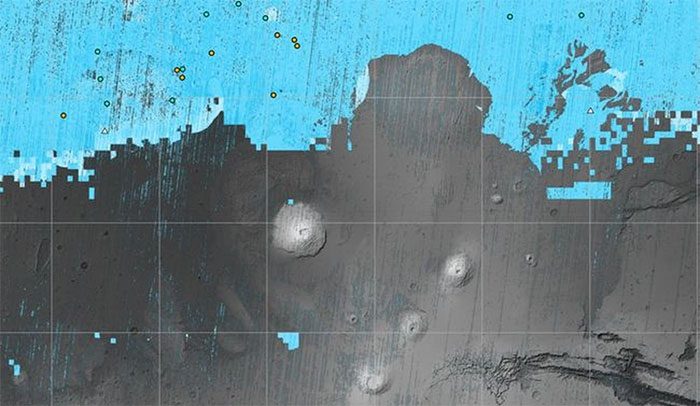Mapping the ice beneath the surface of Mars will assist mission planners in determining potential landing sites for future astronauts.
Recently, NASA officially updated the latest map of Mars based on data from the Context Camera (CTX) and High-Resolution Imaging Science Experiment (HiRISE).
This is part of the Subsurface Ice Mapping on Mars (SWIM) project, led by the Planetary Science Institute and managed by NASA’s Jet Propulsion Laboratory (JPL).

Subsurface Ice Map of Mars (SWIM) released by NASA. (Photo: NASA).
In this project, scientists have cross-referenced data from numerous previous Mars missions to compile a unified map that shows the potential for the presence of ice and water forming beneath the surface of the Red Planet.
With the latest updated map, mission planners can accurately identify small impact craters that are believed to have blown away the Martian surface, revealing a form of “polygons.”
These are areas noted for cycles of melting and refreezing ice, depending on specific seasonal weather patterns on Mars.
According to NASA, knowing where ice can be found on Mars is crucial for planning crewed missions. It represents a “priceless” resource for space missions, as transporting water from Earth is considered extremely costly.
Water found in ice form will be used to extract drinking water, oxygen, and hydrogen… all of which can be utilized to produce rocket fuel, thus reducing the costs of missions.
The data from the map also allows planners to avoid landing astronauts in excessively cold locations.
If temperatures are too low, the crew would need to use valuable energy resources to keep warm for themselves and their equipment. This would make missions more expensive and increase the risk of failure.
“If one day humans set foot on Mars, we will want to land as close to the equator as possible,” said Sydney Do, project director of SWIM.
“At that point, an ideal location would be a land area with the lowest possible latitude, while still containing accessible ice. This is where these Martian ice maps come into play.”
In addition to planning missions, scientists believe they can also use the SWIM map to gain a better understanding of why Mars appears as it does today.
According to Nathaniel Putzig, co-leader of SWIM at the Planetary Science Institute, the amount of ice found at mid-latitude locations on Mars is not uniform.
Specifically, some areas seem to have more ice than others, and no one has been able to explain why.
He noted that the latest SWIM map could help scientists formulate new hypotheses about why these variations occur, as well as identify stable factors of the geological layers on Mars.


















































